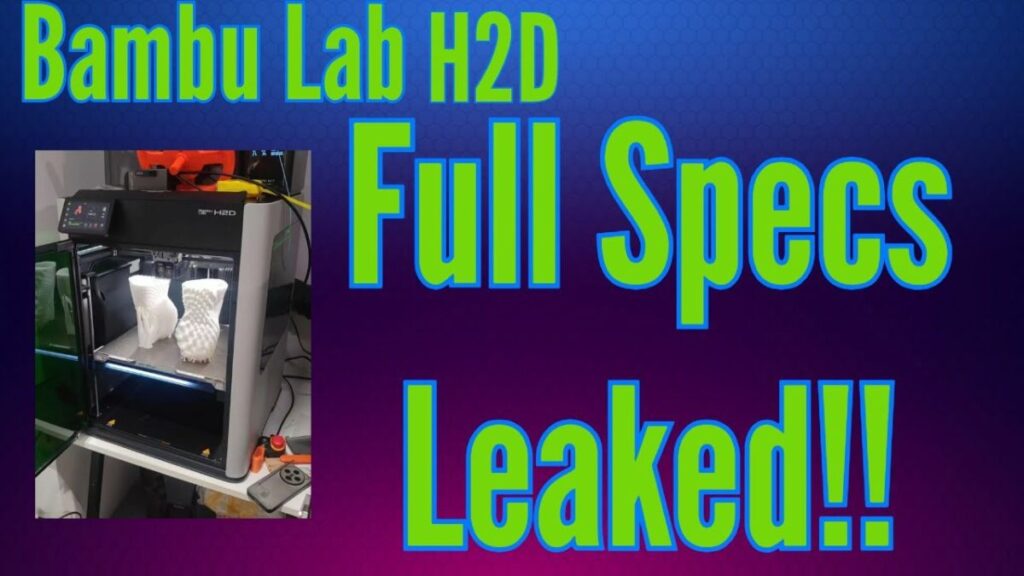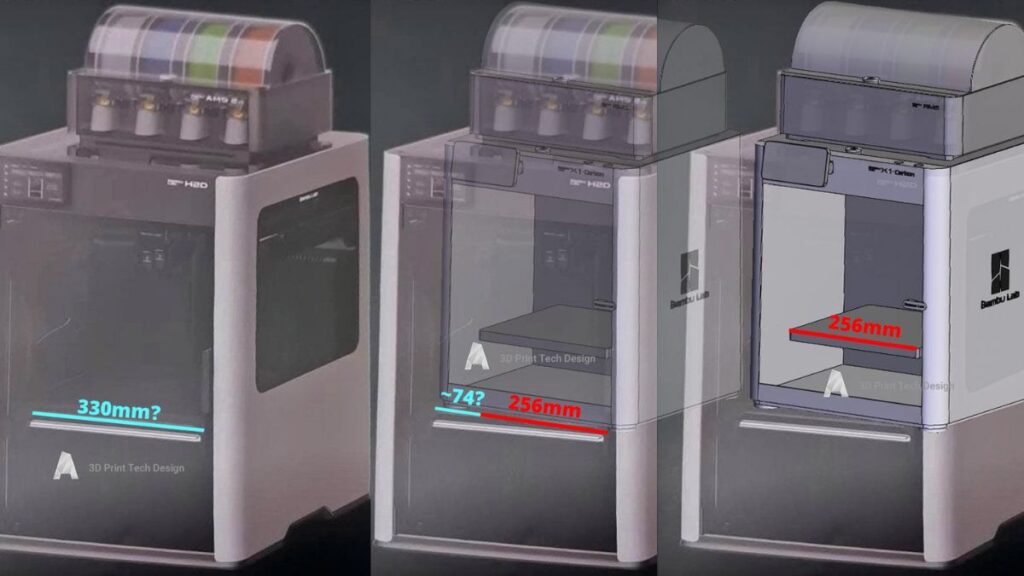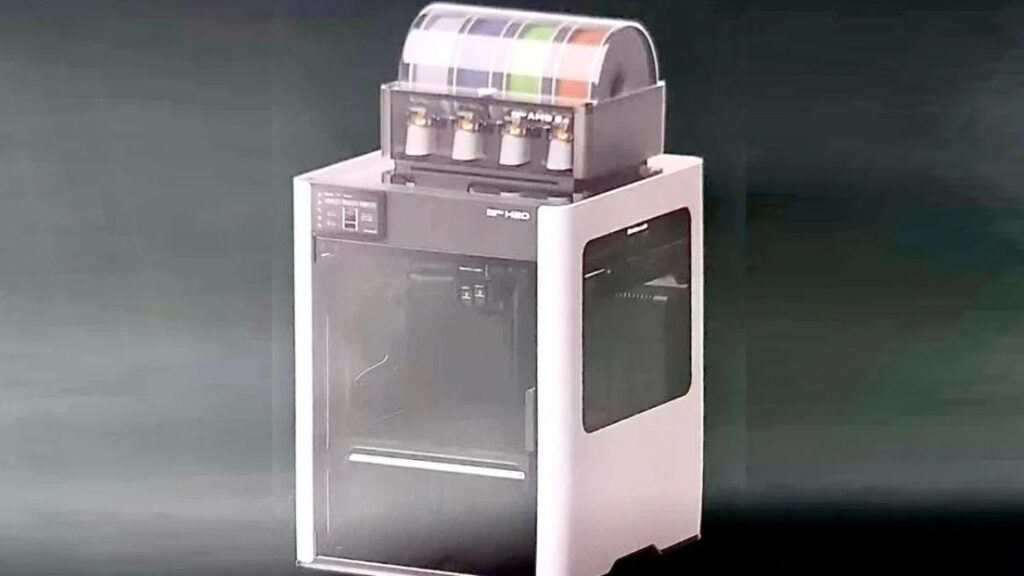Imagine a world where your 3D printer, laser cutter, pen plotter, and vinyl-cutting tool aren’t separate devices cluttering your workspace but a single, sleek machine that does it all.
Sounds like a dream, right? Well, Bambu Lab is turning that dream into reality with their latest creation, the Bambu H2D. This isn’t just another 3D printer—it’s a multi-tool marvel designed to take on the likes of Cricut, GlowForge, and iDraw,
all while pushing the boundaries of what a prosumer crafting device can do. Starting at $1,899, the H2D promises to be a game-changer for hobbyists and creators alike. But does it live up to the hype? Let’s dive in and find out!
A Bigger, Bolder 3D Printer with a Twist
Bambu Lab has been making waves in the 3D printing world for a while now, known for creating machines that are user-friendly yet powerful. Last year, they impressed us with printers that simplified the process for beginners.
But instead of resting on their laurels, they’ve gone big—literally—with the H2D. This beast boasts a larger build area (350 x 320 x 325mm) that’s twice the volume of their earlier X1 and P1 models, meaning you can print bigger projects without breaking them into parts.
But size isn’t the only upgrade. The H2D comes equipped with two nozzles, letting you print with two different materials—like tough PETG laced with carbon fiber and soft, flexible TPU—in one go.
Read Also: Your DNA Is at Risk: Why You Should Delete Your 23andMe Data ASAP
Picture this: a fully printed bicycle helmet with a sturdy shell and cushy padding, all crafted in a single session. No more swapping filaments mid-print and dealing with waste. It’s efficient, it’s clever, and it’s the kind of thing that makes you wonder why this isn’t standard yet.
More Than Just a Printer: Meet the Modular Magic
Here’s where the H2D really starts to shine—or should I say cut, draw, and etch? Beyond its 3D printing chops, this machine comes with a modular attachment system that transforms it into a jack-of-all-trades. Snap on a blade, and it slices through paper and vinyl like a pro, giving Cricut a run for its money.
Attach a pen, and it whips up detailed sketches or schematics faster than you can say “DIY.” And if that’s not enough, you can equip it with a 10-watt or 40-watt laser to engrave wood, burn designs into cork, or even personalize your Apple AirTags (just watch those plastic shells—too much heat, and they’ll melt!).

I love the idea of this versatility. It’s like having a KitchenAid mixer that doesn’t just mix dough but also rolls out pasta and slices veggies—all with the swap of an attachment. The H2D uses its precise CoreXY gantry system (a fancy way of saying it moves super accurately in 3D space) to handle these extra tasks, making it a natural fit for pens, blades, and lasers. Why buy four machines when one can do it all?
3D Printing Upgrades That’ll Make Hobbyists Drool
Let’s zoom in on the 3D printing features for a sec, because that’s still the H2D’s bread and butter. The dual-nozzle setup is a standout, letting you mix materials seamlessly. Bambu’s demo of that bike helmet? It’s not just a gimmick—it shows how this machine can tackle complex, functional projects.
The nozzles are tool-free to swap and can hit temperatures up to 350°C, with high-flow options for faster printing. Only the right nozzle handles TPU, but both can pair with Bambu’s Automatic Material System (AMS) for easy filament switching.
Speaking of AMS, the new AMS 2 Pro (four colors) and AMS HT (single color) are next-level. They’ve got built-in heaters—up to 65°C for the 2 Pro and 85°C for the HT—to dry out filament, which is a big deal since moisture can ruin prints. Plus, electromagnetic vents open and close automatically to keep everything running smoothly.
The printer itself has a 65°C chamber heater and autonomous vents, so your soft plastics won’t warp mid-print. Little touches like a dual wiper system for cleaner nozzles and improved filament feeding show Bambu’s listening to the community and tweaking things for the better.
Laser Cutting and Engraving: Cool, but Proceed with Caution

Now, let’s talk lasers. The H2D offers 10-watt and 40-watt options, and they’re seriously fun to play with. You can etch a Pokémon stencil into wood or turn a kid’s doodle into a custom coaster in minutes. The process is slick: the laser etches, then cuts, all in one smooth operation. But it’s not without quirks.
Safety features like green-tinted windows, flame sensors, and a big red stop button are reassuring, especially since you’re lasering inside a 3D printer. Still, you’ll need to press a physical button to start (no remote lasering here), and Bambu warns you to stick around while it’s running.
I get the caution—lasers and flammable materials don’t always mix well—but the burning smell lingering after a session might make you think twice about using it indoors. An optional fume extractor helps, but it’s not a total fix. On the flip side, laser jobs are lightning-fast compared to 3D printing, so you won’t be babysitting it for long.
Cutting and Plotting: A Cricut Killer?
The cutting module is another gem. It comes with a blade for slicing paper and vinyl and a pen holder that fits various sizes for plotting. Whether you’re crafting custom stickers or sketching a logo, it’s quick and precise.
The magnetic attachments make swapping tools a breeze, and the H2D’s gantry ensures everything lines up perfectly. If you’ve been eyeing a Cricut but balked at the price or subscription fees, this could be your all-in-one alternative.
The new Bambu Suite app ties it all together, letting you design and tweak settings for laser, blade, and pen tasks. It’s a bit basic right now—think simple shapes, text, and QR codes—but community designs are coming in April, which should open up a world of possibilities.
You can even snap a photo of your material on the bed and overlay your project before hitting print. It’s intuitive, though it’s clear the software’s still catching up to the hardware’s potential.
The Catch: It’s Not Perfect (Yet)
Here’s the thing: the H2D is ambitious, but it’s not flawless. Early testers, like Sean Hollister from The Verge, found the 3D printing less reliable than Bambu’s older models like the P1P. Dual-nozzle prints sometimes come out messy—think stray PETG strands or gaps in TPU.

Some units even failed basic tests that cheaper printers aced, prompting Bambu to send replacements. It’s a reminder that this is a complex machine still finding its footing.
The laser and cutting features are promising but feel like add-ons rather than fully baked-in experiences. The burning smell, limited software, and hands-on safety requirements might deter casual users.
And at $1,899 to $3,499 depending on the package, it’s a hefty investment for something that’s not 100% polished yet. Bambu’s betting on updates and community feedback to iron out the kinks, but right now, it’s a bit of a gamble.
Pricing and Packages: What’s Your Flavor?
The H2D comes in a few flavors to suit different budgets and needs:
- Base Model ($1,899): Just the printer, preorders start in June.
- H2D + 10W Laser Combo ($2,799): Adds laser cutting, preorders now, ships end of April.
- H2D AMS Combo: Includes the AMS 2 Pro and extras, in stock now.
- H2D Laser Full Combo ($3,499): 40W laser, cutting module, and all the bells and whistles, preorders now, ships end of April.
It’s a steep jump from Bambu’s entry-level printers, but you’re getting a lot more functionality—if it all works as promised.
Read Also: Gators vs Huskies: Can Florida Stop UConn’s Three-Peat March Madness Magic?
Should You Buy the Bambu H2D?
So, is the H2D the ultimate crafting machine? It’s close. The idea of combining 3D printing, laser cutting, pen plotting, and vinyl slicing into one device is brilliant, and Bambu’s execution is impressive for a first stab.
The larger build area, dual nozzles, and modular tools make it a powerhouse for serious hobbyists. But those growing pains—unreliable prints, a barebones app, and laser quirks—mean it’s not quite ready to dethrone dedicated tools like Cricut or GlowForge.
If you’re a tinkerer who loves bleeding-edge tech and doesn’t mind a learning curve, the H2D could be your dream machine. But if you want plug-and-play perfection, you might want to wait for reviews from seasoned 3D printing pros or hold off for a more refined version.
Either way, Bambu’s onto something big here—literally and figuratively. Keep an eye on this one; it might just redefine what a crafting tool can be!

